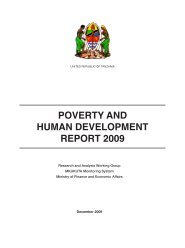Download PDF (4.08 MB) - ReliefWeb
Download PDF (4.08 MB) - ReliefWeb
Download PDF (4.08 MB) - ReliefWeb
Create successful ePaper yourself
Turn your PDF publications into a flip-book with our unique Google optimized e-Paper software.
4<br />
and local economies—contribute to the finding that countries that are emerging from<br />
violent conflict often relapse into conflict during the first five years of peace. 2<br />
The number of disasters in the developing world, and the number of people affected by<br />
these disasters, is rising steadily. Disasters affected three times more people in the 1990s<br />
than in the 1970s, and economic losses were five times higher during this period. The<br />
situation is expected to worsen as global warming increases the frequency and intensity<br />
of severe weather events worldwide. The main determinants of disaster risk include<br />
poverty, vulnerable livelihood systems and strategies, poor urban and local governance,<br />
and deteriorating ecosystems, all of which tend to affect more women than men in developing<br />
countries. Livelihoods that depend on agriculture and other natural resources<br />
are especially vulnerable to unusual or extreme weather patterns. Many urban and local<br />
governments lack the capacity to plan and regulate local development, to enable equitable<br />
access to safe and arable land, and to provide hazard-mitigating infrastructure<br />
and protection. Weak markets, lack of access to markets, trade barriers, and unequal land<br />
access to land and uncertainty around land ownership (particularly for women) all serve<br />
to compound these risk factors.<br />
When a crisis occurs, national and international actors are called upon to respond quickly<br />
to alleviate suffering and to provide a foundation for the swift and sustainable recovery<br />
of livelihoods. The challenge is to maximize the positive impact of recovery efforts while<br />
avoiding unintended consequences that can worsen the situation. Such a challenge requires<br />
an understanding of the crisis context, careful planning, and knowledge that has<br />
been garnered from experiences in other crisis or post-crisis situations.<br />
1.2.2 Key concepts<br />
Rebuilding sustainable livelihood systems and strategies is essential for crisis recovery,<br />
for the prevention of further conflict, and for reduction of the risks associated with subsequent<br />
conflicts and disasters. For the purposes of this Guide, livelihoods are defined<br />
to include the capabilities, assets (both material and social), and activities required for<br />
a means of living. 3 In addition to income and employment, the concept of livelihoods<br />
encompasses any reliable ways that people access food, shelter, health care, education,<br />
safe water and sanitation, security, and protection.<br />
Economic recovery is defined to include market development, strengthening of new<br />
and existing enterprises, and job creation in both the public and private sectors. This<br />
process often involves an umbrella of economic, institutional, legal, and policy reforms<br />
and the reconstruction of infrastructure that facilitates trade and commerce.<br />
Programming for sustainable livelihoods and economic recovery provides an opportunity<br />
to “build back better,” stimulating more rapid and more equitable growth. Inclusive<br />
economic growth occurs when rising economic output in a local or national economy<br />
is associated with expanded livelihood opportunities for all segments of the population<br />
and with safety nets that reduce the economic and social insecurity of vulnerable groups.<br />
2 According to Goovaerts et al. (2005), countries<br />
emerging from violent conflict face a 44-percent<br />
chance of relapsing into conflict in the first five<br />
years of peace.<br />
3 DFID. “The Sustainable Livelihoods Distance<br />
Learning Guide,” in DFID Sustainable Livelihoods<br />
Guidance Sheets. 1999.<br />
The building blocks of livelihoods are referred to as capital assets. They include human<br />
capital (skills, knowledge, experience, and capacities), natural capital (natural resources such<br />
as water, land, forests, and minerals), physical capital (infrastructure, water and sanitation<br />
facilities, information and communication technology, housing, schools, health facilities,<br />
and other community and government structures), financial capital (such as savings, credit,<br />
Livelihoods & Economic Recovery in Crisis Situations





